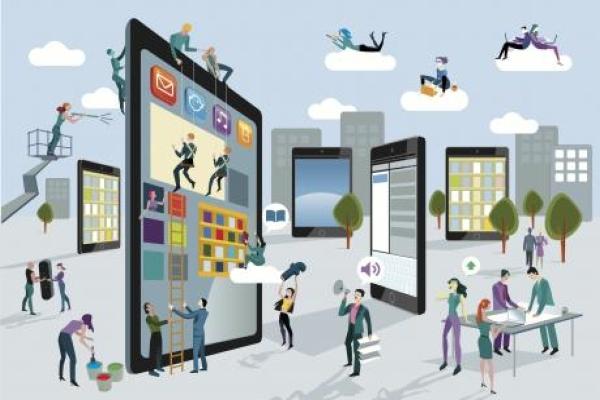Published on the 30/08/2017 | Written by Newsdesk

Ummm aren’t we digital already?…
With Gartner saying that digital workplace programs often lose their way, or fail, due to a fragmented approach that prioritises a few technology fixes over business strategy, the obvious first question is: what’s a digital workplace, then? Fortunately, the researcher has a readily-available glossary, which reveals the following: ‘the digital workplace enables new, more effective ways of working; raises employee engagement and agility; and exploits consumer-oriented styles and technologies’.
It may just be us, but that doesn’t seem particularly well-defined. It is arguable, perhaps, that almost any and every workplace has at least some or all of these characteristics – but the trend is catching on. Modern office refurbishments make concerted efforts to create digital workplaces, where features like open plans, hot desks, little coves with couches and other strangely jarring features (certainly to old school cube-farm office workers) meet the eye.
“The digital workplace promises a more flexible, engaging and intelligent work environment that is able to exploit changing business conditions,” said Carol Rozwell, Gartner VP in a statement. “To be successful, a digital workplace can’t be built in a vacuum. It must be part of a wider business strategy that seeks to boost employee agility and engagement by developing a more consumerised work environment.”
In any event, Gartner said to combat poor navigation towards the digital workplace, it is necessary to employ a framework to address what is calls the eight critical components for a successful implementation.
Source: Gartner (August 2017)
The components are:
- Vision: Describe What Digital Workplace Success Will Look Like
The vision describes the future state of the digital workplace and how it will benefit all stakeholders. It should be consistent with the organisation’s values and serve as a source of inspiration to the stakeholders who will craft the strategy and tactics to realise the vision.
- Strategy: Create a Roadmap to Reach the Destination
The strategy describes the approach an organisation will use to achieve its vision and create a digitally empowered workforce. It clearly defines the strategic roadmap to achieve the organisation’s business goals.
- Metrics: Measure Performance and Value
Measuring the value of digital workplace initiatives should be an extension of the organisation’s current approach. Each initiative should be designed to have a positive impact on a business value metric, such as workforce effectiveness, employee agility, employee satisfaction and employee retention. Effective metrics also provide a feedback mechanism for continuous development of strategy and tactics, serve as great tools for change management, and help structure employee incentives.
- Employee Experience: Design for Improved Employee Interaction
Creating an excellent employee experience is a pivotal aspect of a digital workplace. An engaged, creative and energetic workforce outperforms the competition in terms of service delivery, execution and product design. “The aim should be to increase employees’ participation in any workplace redesign, to create an environment that will make them more effective and connect them better to the outcomes of the business,” said Rozwell.
- Organisational Change: Start Small but Think Big
As digital workplace initiatives mature, they require considerable change to internal processes, departmental structures, incentives, skills, culture and behaviour. Ultimately, digital workplace initiatives will affect every system, process and role within the organisation.
- Processes: Re-engineer How High-Impact Work Is Done
Digital workplace programs are particularly powerful when they set their sights on increasing the effectiveness of people who do high-impact work. Such work benefits from more agile, responsive and collaborative processes that rely more on the ability to respond rapidly to changing circumstances. Re-engineering business processes requires a close look at how employees currently work, to design new work journeys. The new and improved ways of working will involve the addition of new tools to enable collaborative work, use of other new technologies and adaptation of outmoded processes.
- Information: Rework Access and Use of Content and Analytics
Workers expect enterprise tools for searching, sharing and consuming information to be as “smart” and compelling as those they use in their personal lives. They want information and analytics to be contextualized, based on their work, and delivered when they need it. By 2020, algorithms will improve the behaviour of over 1 billion workers.
- Technology: Take a Platform Approach to Workplace Investments
Application leaders responsible for digital workplace programs must work out how to use technology to reach customers, internet-connected “things” and ecosystems. They must also determine how new technologies such as artificial intelligence and the Internet of Things can enable more effective ways of working, and how to exploit the next wave of technology innovation without having to constantly rearchitect.




























